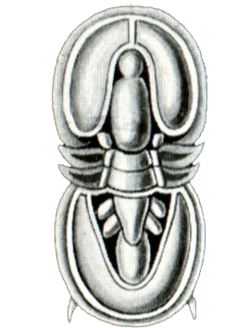User:Abyssal/Portal:Cambrian
IntroductionThe Cambrian ( /ˈkæmbri.ən, ˈkeɪm-/ KAM-bree-ən, KAYM-; sometimes symbolized Ꞓ) is the first geological period of the Paleozoic Era, and of the Phanerozoic Eon. The Cambrian lasted 53.4 million years from the end of the preceding Ediacaran period 538.8 Ma (million years ago) to the beginning of the Ordovician Period 485.4 Ma. The Cambrian is unique in its unusually high proportion of lagerstätte sedimentary deposits, sites of exceptional preservation where "soft" parts of organisms are preserved as well as their more resistant shells. As a result, scientific understanding of the Cambrian biology surpasses that of some later periods. (Full article...) Selected natural world article
The small shelly fauna or small shelly fossils, abbreviated to SSF, are mineralized fossils, many only a few millimetres long, with a nearly continuous record from the latest stages of the Ediacaran to the end of the Early Cambrian period. They are very diverse, and there is no formal definition of "small shelly fauna" or "small shelly fossils". Almost all are from earlier rocks than more familiar fossils such as trilobites. Since most SSFs were preserved by being covered quickly with phosphate and this method of preservation is mainly limited to the Late Ediacaran and Early Cambrian periods, the animals that made them may actually have arisen earlier and persisted after this time span.
The bulk of the fossils are fragments or disarticulated remains of larger organisms, including sponges, molluscs, slug-like halkieriids, brachiopods, echinoderms, and onychophoran-like organisms that may have been close to the ancestors of arthropods. Although the small size and often fragmentary nature of SSFs makes it difficult to identify and classify them, they provide very important evidence for how the main groups of marine invertebrates evolved, and particularly for the pace and pattern of evolution in the Cambrian explosion. Besides including the earliest known representatives of some modern phyla, they have the great advantage of presenting a nearly continuous record of Early Cambrian organisms whose bodies include hard parts. (see more...) Did you know...
Need help?Do you have a question about Abyssal/Portal:Cambrian that you can't find the answer to? Consider asking it at the Wikipedia reference desk. Selected image
Selected science, culture, and economics article
Charles Darwin (12 February 1809 – 19 April 1882) was an English naturalist and geologist, best known for his contributions to evolutionary theory. He established that all species of life have descended over time from common ancestors, and in a joint publication with Alfred Russel Wallace introduced his scientific theorythat this branching pattern of evolution resulted from a process that he called natural selection, in which the struggle for existence has a similar effect to the artificial selection involved in selective breeding.
His five-year voyage onHMS Beagle established him as an eminent geologist whose observations and theories supported Charles Lyell'suniformitarian ideas. Darwin later published his theory of evolution with compelling evidence in his 1859 book On the Origin of Species, overcoming scientific rejection of earlier concepts of transmutation of species. By the 1870s the scientific community and much of the general public had accepted evolution as a fact. However, many favoured competing explanations and it was not until the emergence of the modern evolutionary synthesis from the 1930s to the 1950s that a broad consensus developed in which natural selection was the basic mechanism of evolution. In modified form, Darwin's scientific discovery is the unifying theory of the life sciences, explaining the diversity of life. In recognition of Darwin's pre-eminence as a scientist, he was honoured with a major ceremonial funeral and buried in Westminster Abbey, close to John Herschel and Isaac Newton. Darwin has been described as one of the most influential figures in human history. (see more...) TopicsEpochs - Terreneuvian - Cambrian Series 2 - Cambrian Series 3 - Furongian Geography - Pannotia - Baltica - Gondwanaland - Laurentia - Siberia Fossil sites - Walcott Quarry Researchers - Stephen Jay Gould - Simon Conway Morris - Charles Doolittle Walcott SubcategoriesQuality ContentFeatured Cambrian articles - None Things you can doRelated contentAssociated WikimediaThe following Wikimedia Foundation sister projects provide more on this subject:
|






















